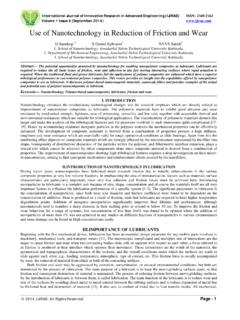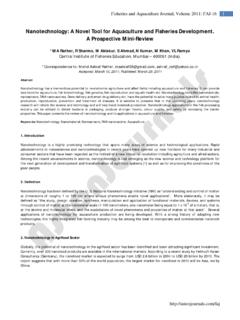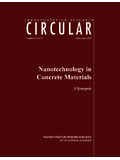Transcription of APPLICATION OF NANOTECHNOLOGY IN THE CORROSION …
1 Proceedings of the 1st African International Conference/Workshop on Applications of Page 103 NANOTECHNOLOGY to Energy, Health and Environment, UNN, March 23 29, 2014 APPLICATION OF NANOTECHNOLOGY IN THE CORROSION PROTECTION OF STEEL OIL PIPES * Wansah1, Udounwa2, Ahmed1, Essiett2 and Jackson3 1 Department of Physics, ModibboAdama University of Technology, PMB 2076, Yola, Nigeria 2 Department of Physics, University of Uyo, PMB 1017, Uyo, Nigeria 3 Department of Chemistry, University of Uyo, PMB 1017, Uyo, Nigeria +2347068082008 Abstract A review of the APPLICATION of NANOTECHNOLOGY in the CORROSION protection of steel oil pipes using appropriate coating has been carried out. NANOTECHNOLOGY is playing an important role in supporting innovative technological advances to manage the CORROSION of steel oil pipes. This paper covers the APPLICATION related to the management of steel oil pipes CORROSION including the use of NANOTECHNOLOGY to produce high-performance coatings with superior abrasion resistance and good CORROSION resistance.
2 Anti- CORROSION coatings in the form of suspension in which nanoparticles ( ,.1 Gal of Gloss: NANO10029, Satin: NANO10033 and Stainless Steel: NANO20001 nanoparticles) are coated layer-by-layer. After the use of nanocomposite additives for anti- CORROSION coatings the surfaces of steel oil pipes designed for very oxidizing and corrosive coastal environments are greatly enhanced. Keywords: NANOTECHNOLOGY , nanoparticles, CORROSION protection, anti- CORROSION coating, steel oil pipes 1 INTRODUCTION Steel is a widely-used engineering material for many industrial applications in manufacturing, construction, defense, transportation, medical, etc. The CORROSION of steel as a result of chemical or electrochemical reaction with its service environment is a spontaneous process, which can compromise the materials integrity and impact assets, environment and people if no measures are taken to prevent or control it.
3 The CORROSION of steel is generally electrochemical in nature and may take many forms such as uniform CORROSION , galvanic CORROSION , pitting CORROSION , crevice CORROSION , under-deposit CORROSION , dealloying, stress CORROSION cracking (SCC), CORROSION fatigue, erosion CORROSION and microbially influenced CORROSION (MIC) [1]. The CORROSION of steel [2], as shown in Fig. 1, is an electrochemical process [3] as given in equations (1 5): Fe Fe2+ + 2e-(1) 2H2O + O2 + 4e- 4OH- (2) 2Fe + 2H2O + O2 2Fe2+ + 4OH- (3) 4Fe2+ + 8OH- 4Fe(OH)2(4) 4Fe(OH)2 + O2 2H2O + (Rust) (5) Fig. 1 CORROSION process in steel [2]. Where is the rust butmost steel pipelines are usually cathodically protected against CORROSION and in addition to cathodic protection, there are many traditional technologies available to mitigate the CORROSION of steel by either enhancing the inherent CORROSION resistance and performance of the steel itself ( , use of stainless steel in place of carbon steel for rebar in concrete), or reducing the corrosivity of the service environment ( , electrochemical chloride extraction for steel reinforced concrete [4]) or altering the steel/electrolyte interface ( , CORROSION inhibitors, metallic coatings, non-metallic coatings, and surface treatment of steel) [1].
4 Most buried pipelines are usually insulated and with time localized CORROSION will occur under the insulation. This can be a particularly severe form of CORROSION because of the difficulty in detection due to the CORROSION occurring beneath insulation. The CORROSION is often times more Proceedings of the 1st African International Conference/Workshop on Applications of Page 104 NANOTECHNOLOGY to Energy, Health and Environment, UNN, March 23 29, 2014 severe due to the insulation not allowing evaporation and the insulation acting as a carrier whereas moisture occurring in one area moves through the insulation to another area causing the CORROSION to spread more rapidly [5]. There is therefore a compelling need to introduce a coating that provides CORROSION resistance and also has a low thermal conductivity, which allows it to act as an insulator. This paper reviews works carried out in protecting the surface of oil pipelines with nanoscale coatings.
5 2 USE OF NANOTECHNOLOGY TO CONTROL STEEL CORROSION Recently, significant advancements have been made to improve the management of steel CORROSION through research, development and implementation; and NANOTECHNOLOGY has been playing an increasing important role in supporting innovative technological advances. NANOTECHNOLOGY is generally understood to involve the manipulation of matter on a near-atomic scale to produce new structures, materials, systems, catalysts and devices that exhibit novel phenomena and properties. Some materials exhibit unique physical, chemical and biological properties at the nanoscale. NANOTECHNOLOGY offers the possibility of introducing technologies that are more efficient and environmentally sound than those used today [6]. NANOTECHNOLOGY has been employed to enhance the inherent CORROSION resistance and performance of the steel itself, by achieving the desirable finely crystalline microstructure of steel ( , nano-crystallization) or by modifying its chemical composition at the nanometer scale ( , formation of copper nanoparticles at the steel grain boundaries) [1].
6 Nanoparticles are smaller than wavelength of visible light (400-700 nm) and hence are transparent to the human eye. They are occupied by 5-10 atoms and molecules, stacked in two or three dimensions [3]. When such nanoparticles are incorporated in a coating, the physical property of the system gets altered without affecting the clarity. Tiny sizes of nanoparticles produce an extra ordinary high surface energy [3]. Advanced materials using NANOTECHNOLOGY may extend service life, reduce failure rates and limit the potential for environmental damage. Nanocoating metallic surfaces can help achieve superhardening, low friction and enhanced CORROSION protection. Stronger materials may reduce wear, CORROSION and the chances of puncturing associated with third-party damage. Also, because nanomaterials can be stronger per unit volume than conventional materials, the use of pipe materials that contain or are coated with nanomaterials may mean fewer disturbances to the environment during installation, maintenance and dismantling.
7 Nanostructure coatings have excellent toughness, wear and adhesion properties. Nanostructure powders have grains less than 100 nm in size, which are agglomerated to form particles large enough to be sprayed using conventional thermal spray methods. These coatings may be used to repair component parts instead of replacing them, resulting in reduced maintenance costs and disturbance. Additionally, the nanostructure coatings may extend the service life of the components because of their improved properties over conventional coatings [6]. Additionally, NANOTECHNOLOGY has been employed to reduce the impact of corrosive environments through the alternation of the steel/electrolyte interface ( , formation of nanocomposite thin film coatings on steel). Significant improvements in the CORROSION protection of steel have been reported through the co-deposition of Ni-SiC or Ni-Al2O3nanocomposite coatings on mild steel [7-8] and the APPLICATION of TiO2-naoparticle sol-gel coatings or multilayer polyelectrolyte nanofilms on 316L stainless steel [9,10].
8 The incorporation of nano-sized particles ( , polyaniline/ferrite, ZnO, Fe2O3, halloysite clay and other nanoparticles) into conventional polymer coatings also significantly enhanced the anti-corrosive performance of such coatings on steel substrates [11-16]. Recent progress in the use of nanomaterials for CORROSION control is summarized in a 2007 review article [17], which discussed the incorporation of nanoparticles in ceramic coatings, polymer coatings and hybrid sol-gel systems for improved properties ( , resistance to CORROSION and high-temperature oxidation, self-cleaning and anti-fouling). NANOTECHNOLOGY has been utilized in endowing the steel bulk materials with excellent CORROSION resistance and other enhanced properties, mainly by refining their crystal grains to the nanometer scale [5]. NANOTECHNOLOGY Solution to Pipeline CORROSION under Insulation CORROSION is the deterioration of essential properties in a metal due to reactions with its environment.
9 In the most common usage of the word, CORROSION means the loss of electrons of metal reacting with either water or oxygen. CORROSION under insulation is a localized CORROSION occurring at the interface of a metal surface and the insulation on that surface. This can be a particularly severe form of CORROSION because of the difficulty in detection due to the CORROSION occurring beneath insulation [17]. Inspections for CORROSION under insulation are generally not completed regularly enough to eliminate this problem due to the cost of insulation removal and replacement and cost of labour. Moisture combined with oxygen is the largest contributing factor to CORROSION . The closed environment of the insulation material over the pipe, tank or equipment creates conditions that encourage Proceedings of the 1st African International Conference/Workshop on Applications of Page 105 NANOTECHNOLOGY to Energy, Health and Environment, UNN, March 23 29, 2014 build up of moisture and resulting CORROSION [18].
10 The CORROSION is often times more severe due to the insulation not allowing evaporation and the insulation acting as a carrier whereas moisture occurring in one area moves through the insulation to another area causing the CORROSION to spread more rapidly [3]. Warm temperatures normally result in more rapid evaporation of moisture and reduced CORROSION rates; however a surface covered with insulation creates an environment that holds in the moisture instead of allowing evaporation. Traditional thermal insulation materials contain chlorides. If they are exposed to moisture, chlorides may be released into a moisture layer on the pipeline surface and pitting/stress CORROSION cracking may result. Acids, acid gases and strong bases like caustics and salts are aggressive corrosive agents and will not only cause but also accelerate existing CORROSION under insulation.







